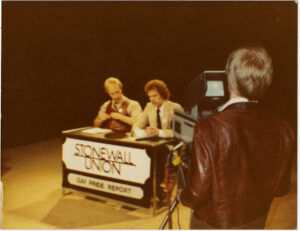Happy Pride!

Good morning readers, and happy Pride!
Each year, queer folk and those who love us celebrate the month of June as pride month. Since you may already be familiar with pride month’s origins at Stonewall Inn in Greenwich Village, New York City, we at Ohio Memory would like to highlight some of Ohio’s own LGBTQ+ history.

You could start with the Michael O’Brien collection, which documents gay life in Columbus, Ohio, mostly in the 1980s. Among photographs of community events and memorabilia, this collection also includes materials such as a pamphlet for the 1983 Columbus Gay Pride Parade, the LAMDA Men’s Chorus at a Stonewall Union* event co-sponsored by the Columbus Association of Black and White Men Together (ca. 1981), and a photograph of the filming of the first Gay Pride Report, a late-night televised program for members of the LGBT+ community in central Ohio (ca. 1981). This archival collection donated by O’Brien and Stonewall Columbus forms just part of the Gay Ohio History Initiative digital collection–which showcases materials from all across the state. You can read more about the digital collection in its inaugural blog post from 2012.
*Stonewall Union is now known as Stonewall Columbus, which continues to host pride marches in Columbus, Ohio, each year.
Or, you could hear our voices directly in the Oral History Collection. Many of these oral histories discuss the joys and challenges of being a member of the LGBTQ+ community, and include several advocates for the historic end to the U.S. military’s “Don’t Ask, Don’t Tell” policy–which, for those who don’t remember, ended in 2011. Some highlighted interviews include Luster Singleton, a transmasculine activist and Drag King performer, Robert P. Howle, who talks about his experiences as a gay man in various contexts across the United States from the 1940s to 1980s, and Phebe Beiser and Victoria Ramstetter of the Ohio Lesbian Archives based in Cincinnati, as they discuss the archival work of preserving lesbian literary, political and community histories.

You may notice that many of our historical queer resources are actually quite recent. Whether due to evolving language and ideas about queerness that make existing resources difficult to define, or to reduced availability of materials preserved as archival collections in the first place, it’s no surprise that our collecting history is lopsided. It was only in 2015 that marriage equality was established across the United States as a protected, fundamental right. And in fact, the lawsuit that established it at a national level, Obergefell v. Hodges, began in Ohio. This civil rights case was actually a consolidation of six cases, but the names refer to James “Jim” Obergefell, from Sandusky, Ohio, and Richard A. Hodges, acting in his capacity as the then-Director of the Ohio Department of Health.
Jim Obergefell and John Arthur, Ohio residents, had been together for 20 years when they legally married in Maryland in 2013. The rapid progression of John’s amyotrophic lateral sclerosis (ALS) diagnosis, meant, however, that they would soon have to consider death certificates–which, according to Ohio law, would not list Jim as John’s surviving spouse due to the state’s ban on same-sex marriage, despite the fact that they were already legally married. Simply put, this was discrimination. In a landmark decision on June 26, 2015, represented along with five other cases from Ohio, Michigan, Kentucky and Tennessee, the Supreme Court affirmed that the fundamental right to marry is indeed guaranteed to same-sex couples. This overturned the existing principle by which each state determined whether same-sex couples could marry–or have their legal rights and benefits recognized from marriages made in other jurisdictions.

Naturally, this ruling deepened divisions in some areas (see article, “Marriage equality is the law of the land”, published six months after the Supreme Court ruling), and revealed or broadened acceptance in others (see article, “After ruling many are in favor of marriage equality,” published six days after the Supreme Court ruling). And, as one article lays out, the march for LGBTQ+ equality is yet ongoing.
So, let’s take a moment to remember our history, mourn the losses of life and knowledge, and celebrate ourselves and our loved ones this month. The future of our community stands on solidarity, and what better way to build it than by becoming familiar with what already surrounds us?
Deep breaths, loud cheers, and warm wishes. Happy Pride!
Thank you to Jen Cabiya, Digital Projects Coordinator at the Ohio History Connection, for this week’s post!



Leave a Reply
You must be logged in to post a comment.